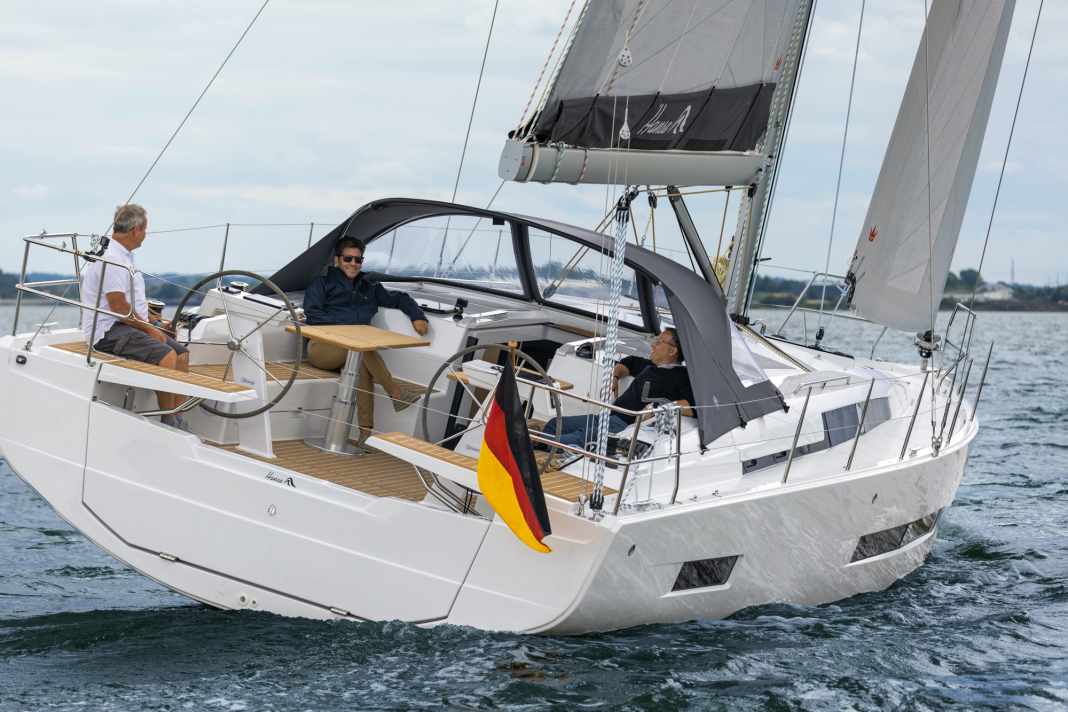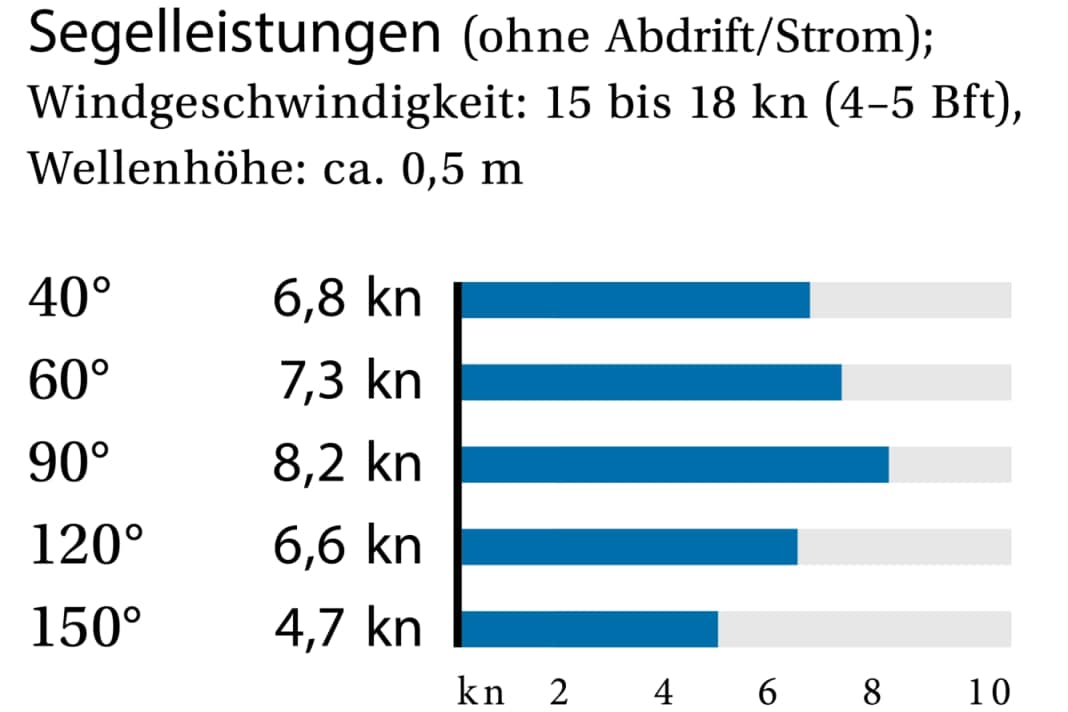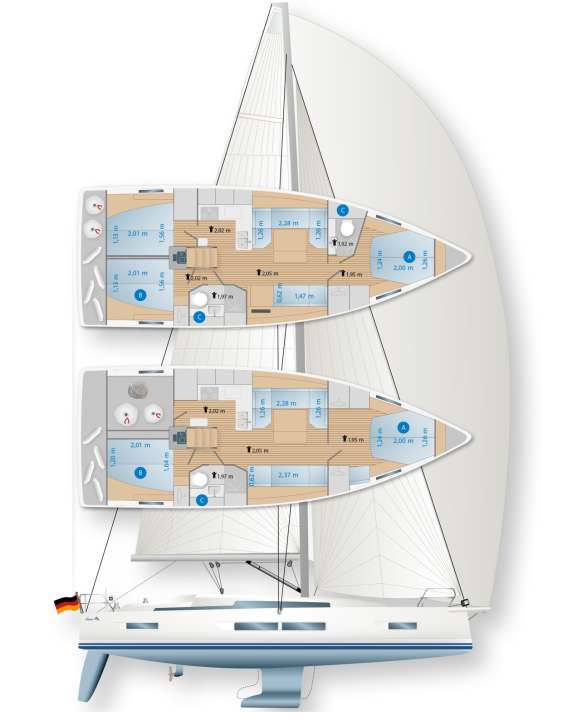





On show at boot Düsseldorf in Hall 15, Stand A20
The unwelcome news comes just a few days before the test date: "The pads won't arrive on time," announces Hanse project manager Andy Unger on the phone, with audible frustration. Supply problems - once again. In post-pandemic times, the shipyards have almost become accustomed to the complications in the supply chains and the associated inconveniences. Even if the situation seems to be easing somewhat, the problems are still omnipresent. And they particularly affect the large shipyard series with their extremely tightly synchronised production processes.
The fact that the cushions for the brand new Hanse 410 are not available for the YACHT test is initially annoying, especially for the photo and film shoots during the test run. But cancelling the appointment and postponing it until later? No! Because the fresh Hanse now comes as an important and relevant addition to the highly competitive class of touring boats with a hull length of twelve metres. And with the launch of the Hanse 410 from Greifswald, the market segment is now more up-to-date than ever before. The French company Dufour Yachts recently presented the exciting 41. Bavaria Yachtbau launched its C42 just three years ago, while market leader Beneteau also launched the Cruiser 40.1. The oldest boat in the competitive field is the five-year-old Sun Odyssey 410 from Jeanneau.
Always wider with the same length
Nota bene, all the ships in this competition are completely new designs. And they all have one thing in common: a hull length of exactly 11.99 metres. The format of less than twelve metres is relevant both in terms of the tax class and for the occupancy of port berths and their fees. The hull widths, on the other hand, are different and also provide a clear picture of the direction in which the designs of modern cruising yachts are currently developing.
With a hull width of 3.99 metres, the Sun Odyssey 410 from Jeanneau is the oldest and also the slimmest boat in the competition. Her aspect ratio is 3.0, which was previously considered normal for touring yachts. In contrast, this year's new launches, the Dufour 41 and Hanse 410, are significantly more voluminous with widths of around 4.30 metres. The aspect ratio is less than 2.8, which seems to be the new standard for cruising boats of this size.
Hanse 410 as successor to the 415
The Hanse 410 is now the successor to the Hanse 415 and its revised version, the Hanse 418. The design from the office of Judel/Vrolijk & Co in Bremerhaven has been on the market for over ten years and has become a bestseller for the yacht builders in Greifswald.
The 410 is now the third boat from the new design co-operation between Hanse and the designers at Berret-Racoupeau Yacht Design in France. As the highly acclaimed first model in the new series, the Hanse 460 immediately won the European Yacht of the Year award in the cruising yacht category. The larger Hanse 510 with its similar concept plus additional dinghy garage followed a year later
Unique selling points of the Hanse 410
A comparative look at the market environment in the twelve-metre class would be tempting to say: "They all look the same now." In fact, a certain visual homogeneity within the class cannot be denied. On closer inspection, however, the differences and unique selling points become apparent, in the case of the Hanse 410 particularly with regard to the cockpit design. All halyards, sheets, reefing and trim lines are concealed on the cockpit and recessed from the coaming to the helm stations. On the competition, at least some of the lines such as halyards and outhauls are operated laterally from the companionway on the coachroof.
Both have advantages and disadvantages. In the case of the Hanse 410, the helmsman can access all the functions for setting and trimming the sails himself from his working area, making the boat suitable for single-handed sailing. And: the front part of the cockpit remains free of lines, which pleases fellow sailors. On the other hand, there are a lot of sheets on the stopper batteries aft in a very small space, and there is only one winch available on each side. An overview is therefore required when manoeuvring, and the many lines can quickly become tangled up in a winder.
As a second exclusive feature within the competition, Hanseyachts offers a layout with two separate tables in the cockpit for the 410, as with the larger sisters 460 and 510. This creates a clear passage through the cockpit and also allows comfortable seating with plenty of space in the harbour or in the bay.
Optional tables are installed on the test boat, which can be lowered at the touch of a button and, if necessary, enlarge the seat bays to form a sunbed. However, these tables stand wobbly on their telescopic legs and are also not suitable for standing on, for example for packing the mainsail into the lazy bags, which also proves to be quite difficult in this case. Hanse therefore continues to offer the robust, centre-standing single table as an alternative.
New rig for the Hanse 410
The yacht builders in Greifswald have changed their rig supplier for the Hanse 410. The mast, the standing rigging and the main boom now come from Z-Spars in France and no longer from Seldén Mast in Sweden. The shipyard representatives say they are very satisfied with the quality, design and functionality of the French version.
The self-tacking jib - formerly an exclusive Hanseyachts trademark - is now fitted to all competitor boats from the shipyard or is at least available as an option. A short overlapping genoa with a little more sail area and hoisting points on deck is also standard in the class as an alternative.
The trimming equipment of the Hanse 410
On the Hanse 410, the mainsheet is guided by a split bulkhead buoy on the coachroof in front of the companionway. The simple sheet run is also standard for the class, but is notoriously inefficient. Because the hoist only starts in the centre of the main boom and not at the back of the nock, hauling the mainsail tight and trimming it flat requires a lot of strength. The 45 mm Lewmar sheet winches on the Hanse 410 are too small for this. The optionally available electric drives are therefore recommended.
Apart from that, handling is also extremely easy in manoeuvres, especially of course with the self-tacking jib. The helmsman sits comfortably at the side and is slightly raised to protect him from overhanging water. This allows him to steer with a clear view and reach the winch perfectly for all functions and manoeuvres. However, there are no footrests for a better grip when the boat is heeling. Co-sailors who want to actively participate, on the other hand, have it less easy. The aft winches can only be reached to a limited extent from the cockpit, especially because the two tables, as on the test boat, largely block access to the stoppers and winches.
Very good performance data
For the YACHT test on the Greifswalder Bodden, there is little wind at the beginning and then significantly more during a second test run. With 15 to 18 knots of wind (4 to 5 Beaufort) and only a slight swell, the 9.85 tonne displacement construction from Berret-Racoupeau proved to be powerful and ran unusually well upwind. The test boat, equipped with a self-tacking jib, tacked at an angle of just 80 degrees and sailed at a speed of 6.8 knots. According to the usual conversion formula, the Hanse 410 thus achieves a windward speed (VMG) of 5.1 knots when tacking, which is already very good for cruising yachts of this orientation. With significantly less wind (2 to 3 Beaufort), the Hanse 410 still sails high upwind, but feels somewhat under-rigged with the standard jib.
Measured values of the Hanse 410





The steering behaviour of the 410 is excellent. The voluminous and, with a total weight of almost ten tonnes, not reportedly light ship can be steered easily and sensitively on the windward edge. The helmsman is pleased with the pleasant pressure on the deep and relatively large single rudder, which makes it easy to optimise steering, especially upwind.
Jefa's steering system works via a continuous cable that connects the quadrant to the two steering columns - a common but non-redundant installation. The autopilot is connected directly to the quadrant, which means that the boat can still be steered in the event of a technical defect, even without an emergency tiller. The rudder quadrant is easily accessible under a hatch in the aft deck for adjusting the cables.
Open design below deck of the Hanse 410
When it comes to the layout options below deck, Hanseyachts adheres to the usual class standards, which are essentially also offered by the relevant competition in a similar form, but with minor variations. This means: owner's cabin forward, plus either one or two double cabins aft, with the option of a large cockpit locker that can be accessed from inside and from the cockpit. There is also a wet room with separate shower aft and the option of installing an additional toilet room for the owners in the foredeck. The twelve metre hull length format generally does not allow for much more variance. Only the new Dufour 41 is an exception, with its configuration options for the charter business with up to four cabins or three heads compartments.
With regard to the design of the saloon, it is once again worth comparing with the competition. While the French competitors from Beneteau, Dufour and Jeanneau build large galley modules as long rows or in a U-shape to the side of the saloon and do without a second sofa bed, the German boats from Bavaria and Hanseyachts rely on the more conventional layout with the galley in an L-shape to the side of the companionway and more space for more people to sit on both sides around the saloon table.
However, this does not mean that the galley in the Hanse 410 does not offer enough space. Thanks to the covers over the two-burner hob and the sinks, the work surface remains large. And there is also space for larger kitchen accessories such as pans, pots or a teapot in the numerous, cleverly organised storage compartments.
Additional versatility is offered for the saloon area, where a multifunctional piece of furniture can be positioned on the starboard side. The body can be used as a navigation table, a shelf for small items, a desk or storage space. In the standard version, however, the long sofa remains on the starboard side. With a length of 2.37 metres and a width of over 60 centimetres, it can also be used as a fully-fledged berth, for example for the free watch on long trips. A leeward sail could be retrofitted for this purpose.
Some of the bunks are tight
In the foredeck of the Hanse 410, the island bed is built extremely far into the bow. The unusually voluminous hull in the stern area makes this possible. As a result, the extension concept gains space in the foredeck for plenty of freedom of movement, huge storage spaces and the possibility of fitting an additional toilet area of a reasonable size. Nevertheless, the bunk in the foredeck remains tight for two people sleeping with their heads forward. The berth is only 1.26 metres wide at shoulder height.
The double berths aft offer more space with a width of 1.56 metres each. If the customer chooses the option of a large forecastle instead of the second aft cabin, the bulkheads of the separating technical duct are moved a little to port. This increases the width of the berth in the remaining cabin by around eight centimetres.
The optimised ventilation options are also worth mentioning. All living and functional areas can be ventilated transversely thanks to at least two openings. In the saloon, all the windows in the superstructure can be opened as standard, and there are no fewer than five hatches in the foredeck. So there is definitely no lack of light and air in the Hanse 410.
An electric motor is possible
As standard ex shipyard, Hanseyachts equips its new 410 with a built-in diesel from Yanmar with Saildrive and an output of 39 hp. Experience has shown that this output seems rather low for a 40-foot-long boat weighing almost ten tonnes. An engine with 57 hp is available as a recommended option. The test boat is also equipped with this upgrade and manages 8.3 knots at full load and 7.8 at cruising speed. Hanseyachts now also offers an electric motor as an alternative for the Hanse 410. A generator for power generation can be integrated into the large forecastle of the two-cabin boat on request. If the 410 is equipped with three cabins, the additional energy supplier remains an option.
With its straightforward, unpretentious touring concept, the Hanse 410 has a solid foundation for a successful market presence. But beware: the competition is just as attractively positioned and up-to-date. So it will certainly not be easy for the newcomer from Greifwald, nor for potential buyers who are interested in this size of boat and have to make a decision.

Technical data Hanse 410
- CE design category A
- Hull length 11.99 m
- Total length 12.55 m
- Waterline length 11.55 m
- Width 4.29 m
- Draught/alternative 2.10/1.70 m
- Mast height above WL 19.99 m
- Theoretical hull speed 8.3 knots
- Weight 9.85 tonnes
- Ballast/proportion 2.37 t/24 %
- Mainsail 49.0 m²
- Self-tacking jib 35.0 m²
- Genoa (110 %) 43.0 m²
- Engine (Yanmar) 29 kW/39 hp
- Fuel tank (PVC) 160 litres
- Fresh water tanks (PVC) 295 litres
- Holding tank 54 litres
Hull and deck construction
GRP sandwich constructions built in hand lay-up with balsa wood core. Vinyl ester resin for the outer layers of the laminate
Equipment and prices
- Base price ex shipyard € 299,760
- Price ready to sail 306.295 €
- Comfort price € 337,190
How the prices shown are defined can be found here !
Standard equipment included:
engine, sails, sheets, railing, navigation lights, battery, compass, cushions, galley/cooker, bilge pump, toilet, electric coolbox, holding tank with suction
For an extra charge: Sailcloth € 1,415, anchor with chain € 750, fender/mooring € 285, fire extinguisher € 60, antifouling € 2,425, clear sailing handover approx. € 1,600
Guarantee/against osmosis
2/5 years
Surcharge for comfort equipment
- Line-adjustable hollow points € 1,655
- Electric windlass € 1,490
- Tube kicker incl.
- Backstay tensioner incl.
- Jumping cleats 310 €
- Sprayhood € 3,800
- Teak in the cockpit € 4,630
- VHF radio nav. package
- Logger and echo sounder nav. package
- Wind measuring system Nav. package
- Autopilot Nav. package
- Navigation package €13,790
- Charger incl.
- Shore connection with RCD incl.
- 230 volt socket (one) incl.
- 12-volt socket in the sat nav incl.
- Heating € 5,220
- Pressurised water system incl.
- Hot water boiler incl.
- Shower WC room incl.
- Cockpit shower incl.
Also included in the price:
Two cockpit tables, manually folding bathing platform, composite bowsprit with anchor holder, headsail furling system, mast steps
Rig
Aluminium rig from Z-Spars (France) with two spreaders. A furling mast (manual) from the same manufacturer is available as an option. The surcharge: 3,560 euros, gross
Sail
A set of dacron sails from Elvstrøm Sails (main and self-tacking jib) is included in the scope of delivery. An overlapping genoa with hole points on deck is optionally available
Motorisation
Standard Yanmar built-in diesel with 39 hp, Saildrive and 2-blade fixed propeller, optional 57 hp (surcharge 7,600 euros, gross). Also feasible: Electric drive from manufacturer EPT with 25 kW power (18.4 kWh battery capacity), surcharge: 47,590 euros
Standard batteries
1x 90 Ah AGM (starter battery),
1x 160 Ah AGM (service battery)
Shipyard
Hanseyachts AG, 17493 Greifswald; www.hanseyachtsag.com
Distribution
International dealer network
YACHT review of the Hanse 410
The third boat in the new Hanseyachts touring range scored particularly well in the test with its excellent sailing characteristics and strong performance. But the straightforward concept is also convincing. A strong competitor for a strong class
Design and concept
- + Voluminous hull moulds
- + Visually appealing
- + Solid and proven design
- - Upscale price in comparison
Sailing performance and trim
- + Good speed, good height
- + Sensitive control
- + Good one-handed suitability
- - Fellow sailors remain passive
Living and finishing quality
- + Bright, open interior design
- + Perfect ventilation options
- + Large pantry, lots of storage space
- - Narrow island bed in the foredeck
Equipment and technology
- + Electric motor as an option
- + Quadrant very easy to reach
- - Sheet winches too small
- - Handrails missing in the salon
- You might also be interested in these yachts
- Bavaria C38
- Dufour 390
- Hanse 388
- The three yachts in direct comparison

